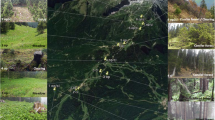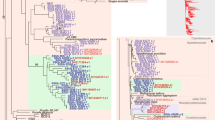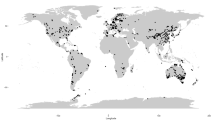Abstract
The effect of genetic markers and reference databases on analyses of fungal communities were estimated using fungal large subunit (LSU) and internal transcribed spacer (ITS) amplicon datasets in consecutive years of rhizosphere samples from three candidate biofuel crops, corn (Zea mays), switchgrass (Panicum virgatum), and miscanthus (Miscanthus × giganteus). These two marker genes were selected to contrast possible differences in biological conclusions. In addition, two ITS schemes based on two ITS reference databases were used to assess differences due to reference database composition. A taxonomy-supervised method was invoked using the Ribosomal Database Project naïve Bayesian classifier that accesses all three databases. The UNITE classification scheme had the highest number of classified taxa in the raw classification result; however, it also had the highest proportion of unknown taxa (sequences that were classified to “unclassified,” “unidentified,” incertae sedis or, in the case of Warcup, to matches containing two unique names). After removal of these unknown taxa, LSU had the highest classification rate followed by Warcup and UNITE. As expected, the communities resolved using the two ITS databases, based on the same sequences, were relatively more similar than those from the lower-coverage LSU classification scheme. The choice of marker gene or even the same reads with different classification databases revealed different community patterns due to database coverage, e.g., the relative abundance of the most abundant groups changed or were only detected in one or two of the classification schemes, such as for Mortierella, Fusarium, and Phoma. No marked difference in fungal beta-diversity was identified among the three methods. Differentiation between the three biofuel crops and between the drought and normal rainfall years was apparent, regardless of method. Though classification rates, taxonomic conflicts, and coverage differences within the high-abundance fungal groups varied according to classification scheme, there was no overall impact on beta diversity among the three methods.






Similar content being viewed by others
References
Anderson MJ (2001) A new method for non-parametric multivariate analysis of variance. Austral Ecol 26:32–46. https://doi.org/10.1111/j.1442-9993.2001.01070.pp.x
Asemaninejad A, Weerasuriya N, Gloor GB, Lindo Z, Thorn RG (2016) New primers for discovering fungal diversity using nuclear large ribosomal DNA. PLoS One 11(7):e0159043. https://doi.org/10.1371/journal.pone.0159043
Cullen DW, Toth IK, Boonham N, Walsh K, Barker I, Lees AK (2007) Development and validation of conventional and quantitative polymerase chain reaction assays for the detection of storage rot potato pathogens, Phytophthora erythroseptica, Pythium ultimum and Phoma foveata. J Phytopathol 155:309–315. https://doi.org/10.1111/j.1439-0434.2007.01233.x
de Gruyter J, Aveskamp MM, Woudenberg JHC, Verkley GJM, Groenewald JZ, Crous PW (2009) Molecular phylogeny of Phoma and allied anamorph genera: towards a reclassification of the Phoma complex. Mycol Res 113:508–519. https://doi.org/10.1016/j.mycres.2009.01.002
De’ath G (2002) Multivariate regression trees: a new techique for modeling species-environment relationships. Ecology 83:1105–1117. https://doi.org/10.1890/0012-9658(2002)083[1105:MRTANT]2.0.CO;2
Deshpande V, Wang Q, Greenfield P, Charleston M, Porras-Alfaro A, Kuske CR, Cole JR, Midgley DJ, Tran-Dinh N (2016) Fungal identification using a Bayesian classifier and the Warcup training set of internal transcribed spacer sequences. Mycologia 108:1–5. https://doi.org/10.3852/14-293
Edgar RC (2010) Search and clustering orders of magnitude faster than BLAST. Bioinformatics 26:2460–2461. https://doi.org/10.1093/bioinformatics/btq461
Flood J (2006) A review of fusarium wilt of oil palm caused by Fusarium oxysporum f. sp. elaeidis. Phytopathology 96:660–662. https://doi.org/10.1094/PHYTO-96-0660
Gilbert J, Tekauz A (2000) Review: recent developments in research on fusarium head blight of wheat in Canada. Can J Plant Pathol 22:1–8. https://doi.org/10.1080/07060660009501155
Hawksworth DL (2001) The magnitude of fungal diversity: the 1.5 million species estimate revisited. Mycol Res 105:1422–1432. https://doi.org/10.1017/S0953756201004725
Hollingsworth CR, Gray FA, Groose RW (2005) Evidence for the heritability of resistance to brown root rot of alfalfa, caused by Phoma sclerotioides. Can J Plant Pathol 27:64–70. https://doi.org/10.1080/07060660509507195
Jesus ED, Susilawati E, Smith SL, Wang Q, Chai B, Farris R, Rodrigues JLM, Thelen KD, Tiedje JM (2010) Bacterial communities in the rhizosphere of biofuel crops grown on marginal lands as evaluated by 16S rRNA gene pyrosequences. BioEnerg Res 3:20–27. https://doi.org/10.1007/s12155-009-9073-7
Jesus ED, Liang C, Quensen JF, Susilawati E, Jackson RD, Balser TC, Tiedje JM (2015) Influence of corn, switchgrass, and prairie cropping systems on soil microbial communities in the upper Midwest of the United States. GCB Bioenergy (2016) 8, 481–494, https://doi.org/10.1111/gcbb.12289
Kõljalg U, Nilsson RH, Abarenkov K, Tedersoo L, Taylor AFS, Bahram M, Bates ST, Bruns TD, Bengtsson-Palme J, Callaghan TM, Douglas B, Drenkhan T, Eberhardt U, Dueñas M, Grebenc T, Griffith GW, Hartmann M, Kirk PM, Kohout P, Larsson E, Lindahl BD, Lücking R, Martín MP, Matheny PB, Nguyen NH, Niskanen T, Oja J, Peay KG, Peintner U, Peterson M, Põldmaa K, Saag L, Saar I, Schüßler A, Scott JA, Senés C, Smith ME, Suija A, Taylor DL, Telleria MT, Weiss M, Larsson K-H (2013) Towards a unified paradigm for sequence-based identification of fungi. Mol Ecol 22:5271–5277. https://doi.org/10.1111/mec.12481
Liang C, Jesus ED, Duncan DS, Jackson RD, Tiedje JM, Balser TC (2012) Soil microbial communities under model biofuel cropping systems in southern Wisconsin, USA: impact of crop species and soil properties. Appl Soil Ecol 54:24–31. https://doi.org/10.1016/j.apsoil.2011.11.015
Liu K-L, Porras-Alfaro A, Kuske CR, Eichorst SA, Xie G (2012) Accurate, rapid taxonomic classification of fungal large-subunit rRNA genes. Appl Environ Microbiol 78:1523–1533. https://doi.org/10.1128/AEM.06826-11
Menkis A, Burokienė D, Gaitnieks T, Uotila A, Johannesson H, Rosling A, Finlay RD, Stenlid J, Vasaitis R (2012) Occurrence and impact of the root-rot biocontrol agent Phlebiopsis gigantea on soil fungal communities in Picea abies forests of northern Europe. FEMS Microbiol Ecol 81:438–445. https://doi.org/10.1111/j.1574-6941.2012.01366.x
Miransari M, Bahrami HA, Rejali F, Malakouti MJ, Torabi H (2007) Using arbuscular mycorrhiza to reduce the stressful effects of soil compaction on corn (Zea mays L.) growth. Soil Biol Biochem 39:2014–2026. https://doi.org/10.1016/j.soilbio.2007.02.017
MSCO (2013) 27 year summary of annual values for Gull Lake (3504) 1981–2010
O’Brien HE, Parrent JL, Jackson JA, Moncalvo J-M, Vilgalys R (2005) Fungal community analysis by large-scale sequencing of environmental samples. Appl Environ Microbiol 71:5544–5550. https://doi.org/10.1128/AEM.71.9.5544-5550.2005
Penton CR, St Louis D, Cole JR, Luo Y, Wu L, Schuur EAG, Zhou J, Tiedje JM (2013) Fungal diversity in permafrost and tallgrass prairie soils under experimental warming conditions. Appl Environ Microbiol 79:7063–7072. https://doi.org/10.1128/AEM.01702-13
Penton CR, Gupta VVSR, Yu J, Tiedje JM (2016) Size matters: assessing optimum soil sample size for fungal and bacterial community structure analyses using high throughput sequencing of rRNA gene amplicons. Front Microbiol 7:824. https://doi.org/10.3389/fmicb.2016.00824
Porras-Alfaro A, Liu K-L, Kuske CR, Xie G (2014) From genus to phylum: large-subunit and internal transcribed spacer rRNA operon regions show similar classification accuracies influenced by database composition. Appl Environ Microbiol 80:829–840. https://doi.org/10.1128/AEM.02894-13
Rodríguez H, Fraga R (1999) Phosphate solubilizing bacteria and their role in plant growth promotion. Biotechnol Adv 17:319–339. https://doi.org/10.1016/S0734-9750(99)00014-2
Sanford GR, Oates LG, Jasrotia P, Thelen KD, Robertson GP, Jackson RD (2016) Comparative productivity of alternative cellulosic bioenergy cropping systems in the north Central USA. Agric Ecosyst Environ 216:344–355. https://doi.org/10.1016/j.agee.2015.10.018
Schöler A, Jacquiod S, Vestergaard G, Schulz S, Schloter M (2017) Analysis of soil microbial communities based on amplicon sequencing of marker genes. Biol Fertil Soils 53:485–489. https://doi.org/10.1007/s00374-017-1205-1
Sul WJ, Cole JR, Jesus ED, Wang Q, Farris RJ, Fish JA, Tiedje JM (2011) Bacterial community comparisons by taxonomy-supervised analysis independent of sequence alignment and clustering. Proc Natl Acad Sci U S A 108:14637–14642. https://doi.org/10.1073/pnas.1111435108
Tedersoo L, Anslan S, Bahram M, Põlme S, Riit T, Liiv I, Kõljalg U, Kisand V, Nilsson H, Hildebrand F, Bork P, Abarenkov K (2015) Shotgun metagenomes and multiple primer pair-barcode combinations of amplicons reveal biases in metabarcoding analyses of fungi. MycoKeys 10:1–43. https://doi.org/10.3897/mycokeys.10.4852
Thangavelu R, Palaniswami A, Velazhahan R (2004) Mass production of Trichoderma harzianum for managing fusarium wilt of banana. Agric Ecosyst Environ 103:259–263. https://doi.org/10.1016/j.agee.2003.09.026
Vandenkoornhuyse P, Baldauf SL, Leyval C, Straczek J, Young JPW (2002) Extensive fungal diversity in plant roots. Science 295:2051. https://doi.org/10.1126/science.295.5562.2051
Vestergaard G, Schulz S, Schöler A, Schloter M (2017) Making big data smart—how to use metagenomics to understand soil quality. Biol Fertil Soils 53(5):479–484. https://doi.org/10.1007/s00374-017-1191-3
Voříšková J, Baldrian P (2013) Fungal community on decomposing leaf litter undergoes rapid successional changes. ISME J 7:477–486. https://doi.org/10.1038/ismej.2012.116
Wang Q, Garrity GM, Tiedje JM, Cole JR (2007) Naive Bayesian classifier for rapid assignment of rRNA sequences into the new bacterial taxonomy. Appl Environ Microbiol 73:5261–5267. https://doi.org/10.1128/AEM.00062-07
White T, Bruns T, Lee S, Taylor J (1990) Amplification and direct sequencing of fungal ribosomal RNA genes for phylogenetics. In: Innis MA, Gelfand DH, Sninsky JJ, White TJ (eds) PCR protocols—a guide to methods and applications. Academic Press, New York, pp 315–322
Xiong W, Zhao Q, Xue C, Xun W, Zhao J, Wu H, Li R, Shen Q (2016) Comparison of fungal community in black pepper-vanilla and vanilla monoculture systems associated with vanilla fusarium wilt disease. Front Microbiol 7:117. https://doi.org/10.3389/fmicb.2016.00117
Xu L, Ravnskov S, Larsen J, Nilsson RH, Nicolaisen M (2012) Soil fungal community structure along a soil health gradient in pea fields examined using deep amplicon sequencing. Soil Biol Biochem 46:26–32. https://doi.org/10.1016/j.soilbio.2011.11.010
Funding
This work was funded by the DOE Great Lakes Bioenergy Research Center, DOE BER Office of Science (DE-FC02-07ER64494 and DE-FG02-99ER62848), the Jiangsu Science and Technology Department (BK20160730), the China Postdoctoral Science Foundation (2017M621761 and 2018T110510), and the Fundamental Research Funds for the Central Universities (KYZ201720 and KYZ201877). We also acknowledge the support of the GLBRC field staff who maintains the field experiment, and for the funding that supports that staff and field operations by the National Science Foundation Long-term Ecological Research Program (DEB 1637653), and by Michigan State University AgBioResearch.
Author information
Authors and Affiliations
Corresponding authors
Electronic supplementary material
ESM 1
(DOCX 965 kb)
Rights and permissions
About this article
Cite this article
Xue, C., Hao, Y., Pu, X. et al. Effect of LSU and ITS genetic markers and reference databases on analyses of fungal communities. Biol Fertil Soils 55, 79–88 (2019). https://doi.org/10.1007/s00374-018-1331-4
Received:
Revised:
Accepted:
Published:
Issue Date:
DOI: https://doi.org/10.1007/s00374-018-1331-4




